The 5 Best Cast-Iron Skillets
Dotdash Meredith and Yahoo Inc. may earn commission or revenue on some items through the links below.
Our favorite cast-iron skillets are destined to become family heirlooms.
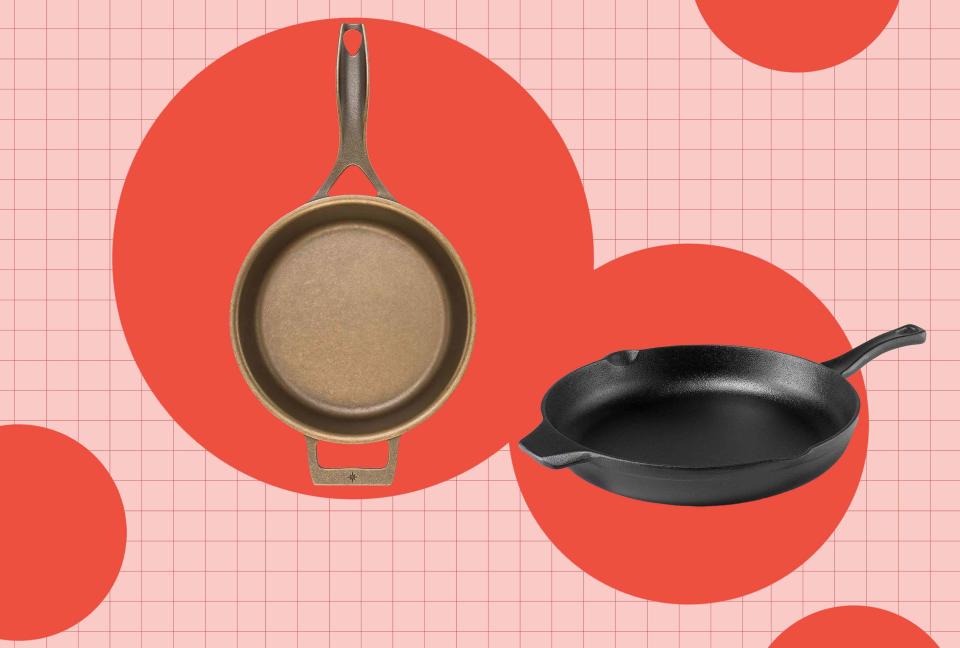
Courtesy of Brand
Reviewed by Dietitian Brierley Horton, M.S., RD
Cast iron has been used for cooking for centuries and for good reason. The heavy skillets produce a perfect sear on meat, a grill-like char on vegetables, and are naturally nonstick when used regularly, with no nonstick coating necessary. They also tend to be reasonably priced, especially for a pan that can be passed on from generation to generation.
All this is to say, if you don’t have a cast-iron skillet, what’re you waiting for? We’ve done the work and tested 21 cast-iron skillets to find the best ones. Here are the cast-iron skillets our testers loved.
Our Cast-Iron Skillet Recommendations
Best Overall: Lodge Preseasoned Cast-Iron Skillet, 10.25-Inch
Easiest to Clean: Calphalon Preseasoned Cast-Iron Skillet, 12-Inch
Easiest to Use: Stargazer 10.5-Inch Cast-Iron Skillet
Best Value: Camp Chef 10-Inch Seasoned Cast-Iron Skillet
Best Lightweight: Lodge 10.25-Inch Blacklock Triple-Seasoned Cast-Iron Pan
Is It Healthy To Cook With Cast Iron?
Cooking with cast iron has several benefits beyond getting the perfect sear on a steak. A well-seasoned cast-iron pan barely needs any fat to cook your food, and it can also add some iron in your diet. While studies show that the amount of iron is fairly low, it’s a convenient way to add a bit of this essential mineral into your meals.
Best Overall: Lodge Preseasoned Cast Iron Skillet, 10.25-Inch
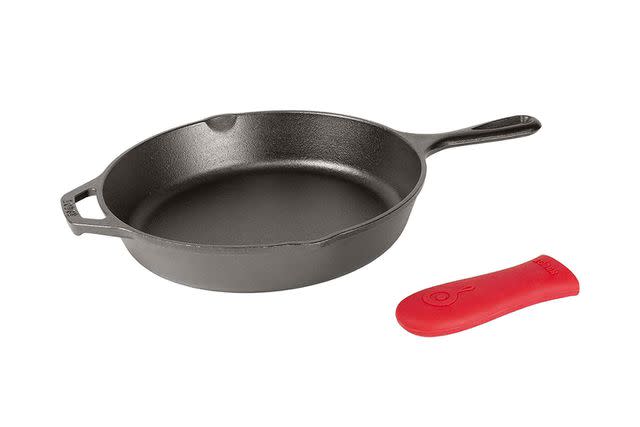
Amazon
What we like: Extremely even browning, best performance at a great price
What to know: A little heavy for those with strength limitations
When it comes to the best bang for your buck, the Lodge cast-iron skillet is our first choice. And when we also found that it performs better at searing, baking and cleaning than all the other pans during testing, we could see why every one of our testers owns a Lodge cast-iron pan at home. The pork was perfectly crisp and brown on both sides, the cornbread was golden and cleaning was merely a wipe-down with a sponge. From home cooks to professionals, this is a pan for every kitchen, especially since it’ll last forever with proper care.
Size: 10 1⁄4 inches | Weight: 5 lbs. 5 oz. | Comes Preseasoned: Yes | Induction Compatible: Yes
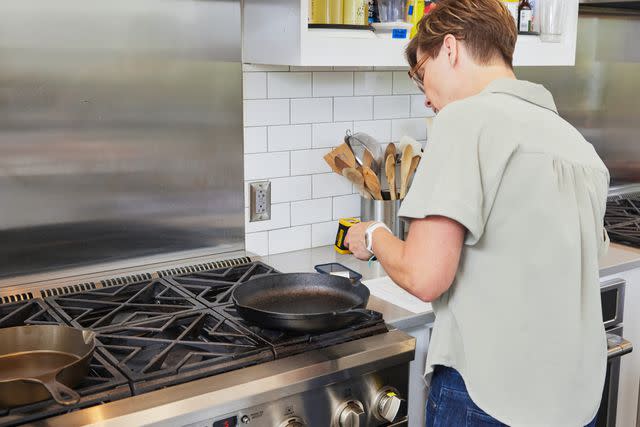
EatingWell / Russell Kilgore
Easiest to Clean: Calphalon Pre-Seasoned Cast Iron Skillet, 12-Inch
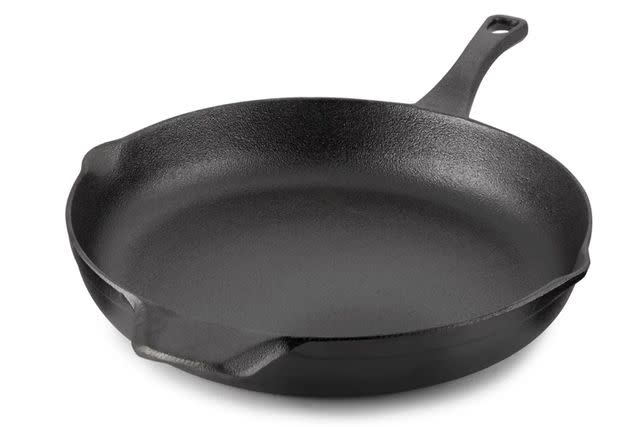
Calphalon
What we like: Larger capacity makes it ideal for feeding bigger crowds
What to know: The heaviest of the pans we tested, so most folks would need two hands to move it
Every cook knows that the worst part of cooking is cleaning. Luckily, this cast-iron pan from Calphalon makes it super easy with just warm water, that’s it. It’s also worth noting that this pan is a great value. You get increased capacity at 12 inches instead of the standard 10 for a very reasonable price. Yes, it is a bit heavier, but with a solid helper handle and a slightly larger main handle, the Calphalon is as easy to maneuver as it is to clean.
Size: 12 inches | Weight: 7 lbs. 1 oz. | Comes Preseasoned: Yes | Induction Compatible: Yes
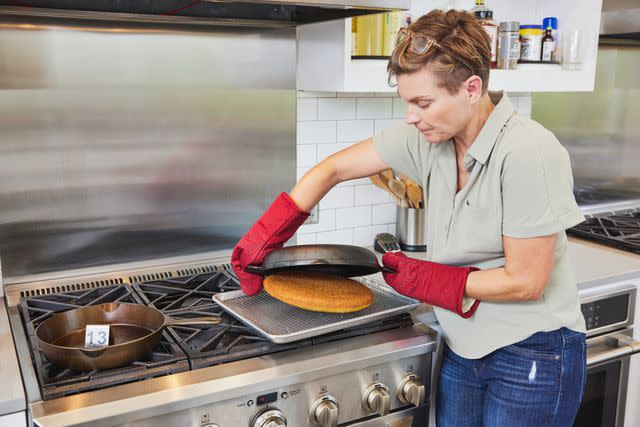
EatingWell / Russell Kilgore
Easiest to Use: Stargazer 10.5-Inch Cast Iron Skillet
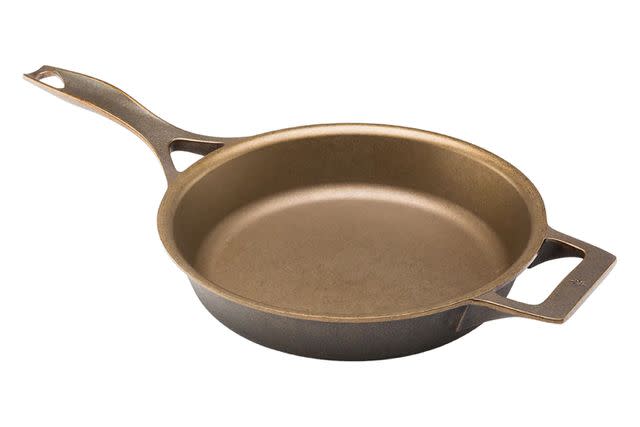
Stargazer
What we like: Large helper handle, easy pouring edge
What to know: More expensive without increased performance
A smooth surface and balanced weight made this a favorite among the pans we tested. The meat seared perfectly, the cornbread came out with a little nudge, and it was incredibly easy to clean. It’s considerably more expensive than a Lodge, but if you want heirloom quality and design, this is the pan for you. Or, if you’re the type of cook who likes to serve in your cast iron, the Stargazer is quite the looker.
Size: 10 1/2 inches | Weight: 5 lbs. 6.25 oz. | Comes Preseasoned: Both preseasoned and unseasoned options | Induction Compatible: Yes
Best Value: Camp Chef 12-Inch Seasoned Cast-Iron Skillet
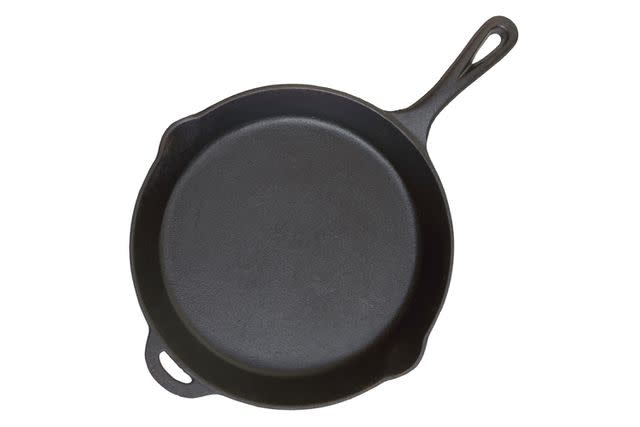
Amazon
What we like: Incredibly consistent searing, very easy to clean, worth the value
What to know: Small helper handle for easier lifting
This cast-iron skillet received a 5-star rating from our testers—and you can find it for $25 at some retailers. It’s well worth the value you are getting out of it. With even searing of meat on both sides, puffy cornbread that slid out of the pan and cleaning that only required a swipe of a paper towel, it’s impossible not to recommend this pan to anyone looking for a cast-iron pan or for anyone looking to get a second cast-iron for their home, camp, rental or RV. It's an ideal pan to use on a portable induction cooktop when traveling, too.
If you can find the 10-inch version of this cast iron skillet (it was out of stock at the time of publish), we also recommend it. In fact, the 10-inch size was what we originally tested in our Test Kitchen.
Size: 12 inches | Weight: 7 lbs. | Comes Preseasoned: Yes | Induction Compatible: Yes
Best Lightweight: Lodge 10.25-Inch Blacklock Triple-Seasoned Cast-Iron Pan
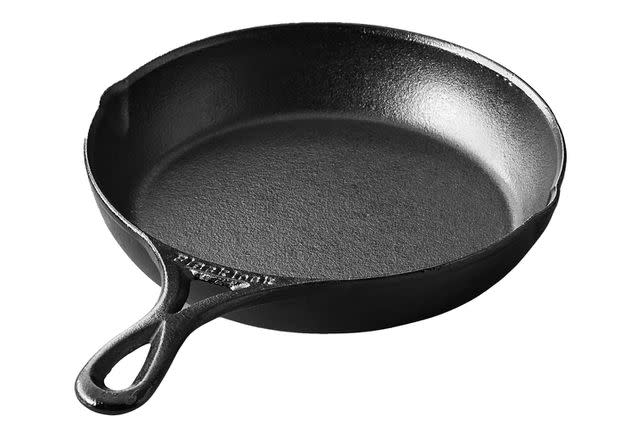
Williams Sonoma
What we like: Lighter weight, triple-seasoning makes it non-stick out of the box
What to know: Doesn’t cook as easily as the original Lodge
One pound and 2 ounces isn’t a lot when you step on a scale, but it makes a big difference when picking up a cast-iron skillet. The Blacklock line from Lodge is the lightweight version of its famous classic skillet—25% lighter to be exact. The sides are slightly more rounded, and the handle has a more teardrop shape, making this pan more visually appealing. During testing, we found that the pan didn’t have quite the same level of even cooking as the original Lodge pan. However, for those who want the capability of classic cast iron without the weight, this is your pan.
Size: 10 1⁄4 inches | Weight: 3 lbs. 14 oz. | Comes Preseasoned: Yes | Induction Compatible: Yes
The Bottom Line: The Best Cast-Iron Skillet
Cast-iron skillets are the workhorses of home and professional kitchens for cooking meat and baking everything from cornbread to cobblers. They also make presentation easy as you can serve directly from the pan, which also means the skillet keeps the food warm on the table. When deciding which one to choose, there’s a reason cooks reach for a classic Lodge skillet (view at Amazon)—they work wonderfully, and the price can’t be beat. If your budget allows and you’re the type of cook who likes to serve in your cast iron, the Stargazer (view at Amazon) is a great pick.
Choosing a Cast-Iron Skillet
Choosing a cast-iron skillet comes down to three factors: coating, size and price. When deciding which is best for you, read on to figure out which is the best for the type of cooking you do most.
Decide on a coating
There are three main types of cast-iron skillets: enameled, bare and preseasoned. An enameled skillet has a glossy coating that prevents most sticking and ensures even heat distribution; however, enameled skillets can’t be heated to as high temperatures as uncoated pans. With an enameled skillet, seasoning (i.e., building up a layer of protection from the iron) is unnecessary. Most cast-iron skillets come preseasoned, meaning they arrive ready to use but need periodic re-seasoning to maintain the nonstick coating. But you can also buy bare cast-iron skillets, which require you to season it yourself. If your skillet needs to be seasoned or reseasoned, it’s a job you can easily do at home.
Select a size based on your household
Cast-iron skillets come in all different sizes: small (6 inches), medium (10 inches), and large (12 inches and larger). Since we’re usually looking to cook two pieces of meat in one skillet, a medium 10-inch skillet is the ideal size. If you’re looking for a larger skillet to serve at least four, opt for a 12-inch or larger skillet. We primarily tested medium cast-iron skillets, but many of us have skillets in other sizes when we want to cook eggs or for a larger crew.
Pricier doesn't always equal better quality
Since a cast-iron pan can last forever with proper care, even the most expensive ones are worth the money. However, you don’t have to spend a lot for a great pan, which makes them even more worth their weight in gold.
Our Cast-Iron Skillet Tests
To find our favorites, we put 21 pans through their paces to see which ones excelled at heat conduction, ergonomic design and nonstick attributes. Testers seared a pork loin to judge how evenly each skillet would sear the protein and baked cornbread to challenge each pan’s nonstick capabilities. Additionally, we asked testers to assess the pourability of oil using the spout (or lack thereof for some of the skillets), and how easy it was to lift and transport each pan. Finally, we rated each skillet on how it cleaned up: Did food residue lift away easily, or did the job require extra elbow grease?
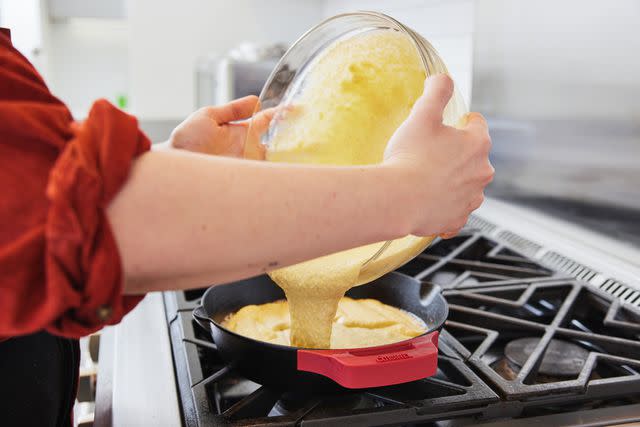
EatingWell / Russell Kilgore
We Also Considered
Finex 10-Inch Cast-Iron Skillet with Lid ($250 at Amazon): If you’re looking for a cast iron skillet that’s also a conversation piece, then this 11-pound octagonal pan is the winner. But if you are looking for a pan that doesn’t require two hands to move or can sear meat without using a lot of oil, then you may want to consider other options.
Smithey No. 10 Chef Skillet ($150 at Smithey): Is it stunningly beautiful? Yes. Does it come close to performing as well as skillets that cost a third of the price? Not even close. Testers found that baking in the Smithey only yielded cornbread that had to be scrubbed off, and we felt there were more affordable options that performed just as well if not better.
Amazon Basics 15-Inch Pre-Seasoned Cast-Iron Skillet ($48 at Amazon): At 11 pounds and a capacity of almost 3 quarts, this skillet is great if you consistently cook for a crowd. Unfortunately, despite its heavy nature and thickness, we found it didn’t heat evenly, and there were a lot of hot spots that yielded unevenly browned meat.
Victoria Pre-Seasoned 10-Inch Cast-Iron Skillet ($30 at Amazon): Meat seared perfectly, but the cornbread stuck in the Victoria cast-iron pan. However, this model featured the deepest oil spouts, and testers found that this would be an excellent choice for anyone who plans to use their cast iron for frying.
Common Questions
Is cast iron nonstick?
Cast iron is not naturally nonstick, but the more you use it (i.e., the more oil and fat you use on the pan), the thicker the seasoning will become and the more nonstick the pan will be. Most cast-iron pans come pre-seasoned now, so all you have to do to keep the coating nonstick is to coat the bottom with a very thin layer of oil each time you wash the pan.
What’s the best way to clean a cast-iron skillet?
When a cast-iron pan is properly seasoned, there should be minimal sticking, and clean up should be as easy as a bit of water and a sponge. However, sometimes food sticks, and we need to scrub the pan with soap and water. This is OK! Simply re-season your pan after use to rebuild the nonstick seasoning.
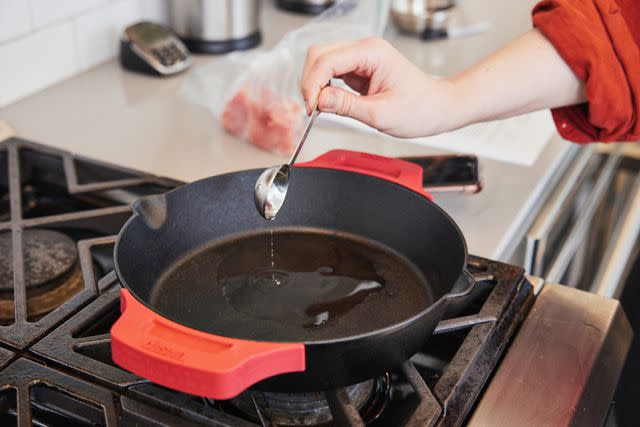
EatingWell / Russell Kilgore
How do I season a cast-iron skillet?
Pre-seasoned cast-iron skillets have layers of seasoning, aka oil, baked into the surface so they come ready to use. However, if you buy an unseasoned cast-iron skillet or find one that needs a bit of rehab, it’s easy to recreate the seasoning. To season a cast-iron pan, first, cover the bottom with a thick layer of kosher salt. The salt is a gentle abrasive that will remove any leftover seasoning without harming the pan. Next, pour in high-heat cooking oil, such as vegetable, avocado or flaxseed, to come up about a half-inch from the bottom of the pan. (Skip oils that burn at a lower heat, such as nut oils, sesame oil or extra-virgin oil.) Place the pan over high heat, and when the oil reaches the smoke point, pour the salt and oil into a heatproof bowl to cool before discarding. Using a ball of paper towels, rub the inside of the pan until smooth. Repeat as needed!
Can I rehab my cast-iron skillet if it has rust or is flaking?
Yes, cast-iron pans that have rust or peeling off can be rehabbed, but it’s a bit of a process. First, you'll need to remove any trace of rust with steel wool and a good soak in soapy water. We know this goes against all previous advice, but remember, you're starting from scratch! Dry the pan thoroughly, then proceed to season your cast iron skillet as outlined above.
What can you cook in a cast-iron skillet?
You can cook almost everything in a cast-iron skillet, from meat to vegetables to baked goods. The only thing we avoid is simmering anything acidic, like tomatoes or a pickle brine, for a long time since the acid can be abrasive to the iron in the pan. And while we keep our cast iron well-oiled, we still reach for a nonstick when making anything delicate or prone to sticking, like eggs or crepes.
Our Trusted Expertise
As a former food editor and test kitchen manager for EatingWell, Breana Killeen has seared, flipped, baked, and edited over 2500 recipes in home and professional kitchens. She owns every size of cast-iron pan and uses one at least once every day.
This article was edited by Katie Tuttle, a food editor and contributor to publications such as Food & Wine and The Spruce Eats, and reviewed by Brierley Horton, M.S., RD, a senior commerce editor with over 15 years of experience writing about nutrition, health and food.
Read the original article on Eating Well.

